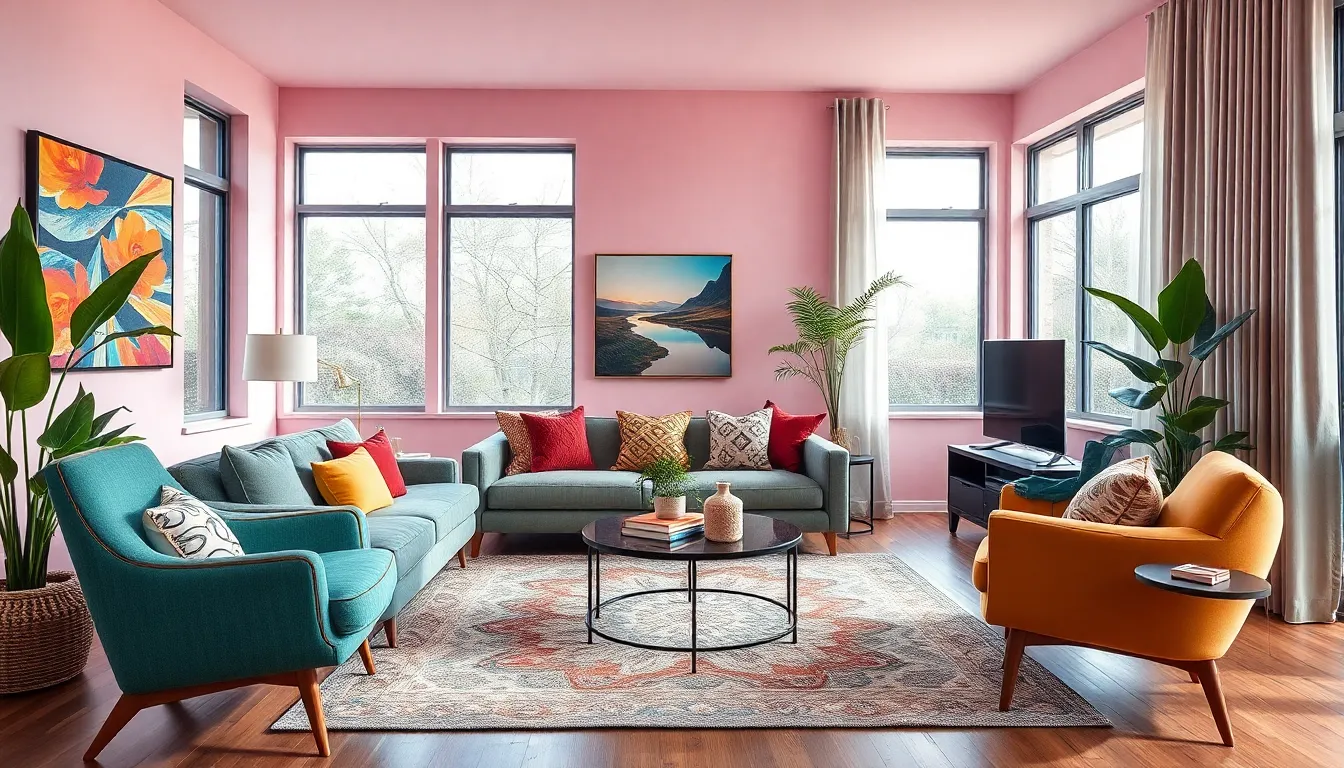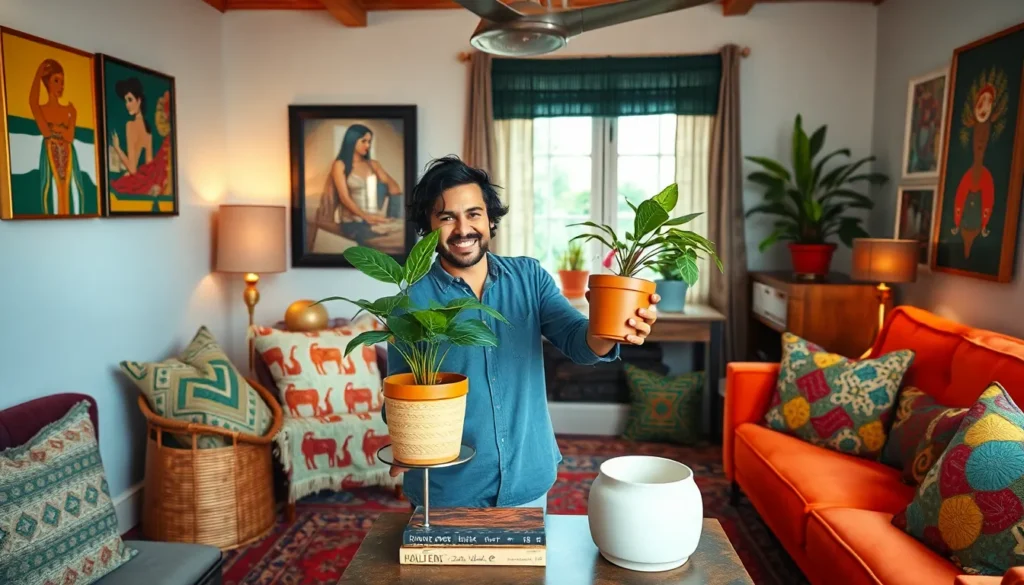In a world where bland walls and mismatched furniture reign supreme, it’s time to unleash the power of decor and design. Imagine transforming your space from a snooze-fest into a vibrant haven that reflects your personality. Whether it’s a splash of color or a quirky piece of art, the right decor can elevate any room from drab to fab faster than you can say “interior designer.”
Table of Contents
ToggleOverview of Decor and Design
Decor and design play crucial roles in shaping environments that mirror individual personalities. Color selection significantly affects mood. Bright, warm tones often create inviting spaces, while cool hues promote calmness. Unique art pieces add character, enhancing visual interest within any setting. Furniture arrangements can transform functionality, allowing for better flow and versatility in everyday use.
Textures contribute depth in a design scheme. Combining materials like wood, metal, and textiles fosters an engaging atmosphere. Accessories, such as cushions or rugs, offer opportunities for experimentation and personalization. Lighting fixtures also hold importance, illuminating key areas while adding style. Choosing the right light can make small spaces feel larger or cozy spaces feel more intimate.
Space planning reveals potential. Understanding dimensions ensures that furniture complements the layout while maximizing usability. Storage solutions are vital in keeping spaces organized. Utilizing hidden compartments or multi-functional furniture helps maintain a clean aesthetic.
Theme consistency enhances overall coherence. Homeowners often choose a central theme, whether modern, traditional, or eclectic, guiding decor choices. It’s essential to select elements that harmonize, creating a unified experience throughout each room.
Incorporating greenery breathes life into interior spaces. Plants improve air quality and contribute color and texture. Choosing low-maintenance varieties ensures that even those with busy schedules enjoy their benefits.
Overall, thoughtful decor and design choices can elevate ordinary spaces into meaningful environments. Prioritizing personal expression while considering functionality fosters spaces that resonate with those who inhabit them.
Key Elements of Decor and Design

Effective decor and design transform spaces, enhancing personal style and creating inviting environments. Key elements include color schemes, furniture selection, and textures and patterns.
Color Schemes
Color schemes significantly influence a room’s atmosphere. Bright colors energize spaces and create inviting settings. In contrast, cool tones promote tranquility and calm, making them ideal for bedrooms or relaxation areas. Complementary colors can provide balance, while monochromatic palettes offer refinement. Selecting colors that resonate with personal tastes ensures a reflective environment.
Furniture Selection
Furniture selection plays a crucial role in both aesthetics and functionality. Functional pieces enhance usability and maintain flow within spaces. Unique design elements like statement chairs or minimalist coffee tables add personality. Ensuring sizes fit the dimensions of a room prevents overcrowding. Ergonomics matter too; comfortable seating invites relaxation and conversation.
Textures and Patterns
Textures and patterns add depth and visual interest to decor. Layering different materials such as wood, fabric, and metal creates a dynamic environment. Incorporating patterns through throw pillows or area rugs introduces character. A balance of textures—smooth surfaces with rougher elements—enriches a room’s experience. Thoughtful combination of these elements cultivates a harmonious look while enhancing sensory engagement.
Popular Trends in Decor and Design
Current trends in decor and design reflect diverse personal styles and preferences. Exploring popular themes helps individuals create unique spaces.
Minimalism
Minimalism emphasizes simplicity and functionality. Clean lines and a limited color palette characterize this approach, creating serene environments. Furniture pieces often feature sleek designs and lack excessive ornamentation. Open spaces enhance the feeling of freedom while promoting a clutter-free lifestyle. Minimalist decor typically includes essential items that serve a purpose, avoiding visual distractions. Natural light plays a crucial role, highlighting the beauty of simplicity in each space.
Bohemian Style
Bohemian style embraces creativity and freedom of expression. Vibrant colors, mixed patterns, and eclectic furnishings define this trend, making spaces feel inviting and dynamic. Layered textiles, like rugs and cushions, offer comfort and warmth. Unique art pieces and handmade decor items enhance the character of these environments. Plants are often abundant, bringing a lively and organic touch. Bohemian spaces encourage individuality, allowing personal stories and experiences to shine through.
Industrial Aesthetics
Industrial aesthetics draw inspiration from urban environments and repurposed materials. Raw elements, such as exposed brick, metal fixtures, and wooden accents, create a rugged charm. Neutral color schemes often dominate, allowing bold accents to stand out. Designers focus on open floor plans that emphasize functionality, attracting individuals to a more minimalist lifestyle. Lighting fixtures with an industrial flair, like pendant and floor lamps, enhance the overall ambiance. This style appeals to those drawn to urban sophistication and modern design.
The Role of Functionality in Decor and Design
Functionality plays a critical role in decor and design, as it combines aesthetics with practicality. Designers prioritize how spaces serve their intended purposes while maintaining visual appeal. Unique furniture choices contribute to both style and usability, ensuring that individuals enjoy their surroundings.
Incorporating functional elements, such as multi-purpose furniture, maximizes available space. Examples include sleek coffee tables with storage or ottomans that double as seating. Thoughtful arrangements enhance flow and accessibility, making it easy to navigate a room.
Balance between comfort and style is essential. They can select seating that complements the overall look yet remains cozy for users. Lighting also serves a functional purpose while adding ambiance. Fixtures with adjustable brightness levels provide flexibility depending on the activity or mood.
Textures and patterns should enhance the visual experience while remaining practical. For instance, durable fabrics withstand daily wear while adding character. Color choices impact not only aesthetics but also how a space feels; warm tones evoke coziness while cool tones create calm environments.
Ultimately, functionality in decor and design ensures that spaces reflect personal styles while serving everyday needs. Focusing on real-world applications allows individuals to create environments that enhance both livability and enjoyment. Prioritizing functionality transforms a room from merely a space into a well-designed experience.
Decor and design play a crucial role in shaping environments that reflect individual personalities and lifestyles. By making thoughtful choices in color, furniture, and textures, anyone can create spaces that are not only visually appealing but also functional. Embracing popular trends like minimalism, bohemian style, or industrial aesthetics allows for personal expression while maintaining a cohesive look.
Ultimately, the blend of aesthetics and practicality elevates ordinary spaces into meaningful experiences. Prioritizing these elements ensures that every room serves its purpose while showcasing unique character. With the right approach to decor and design, transforming a space into a vibrant reflection of oneself is entirely achievable.



